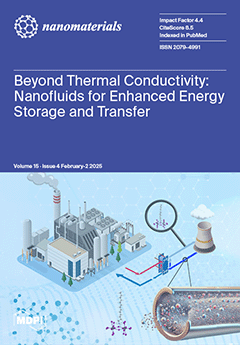In this work, we developed nanostructured Bi
2Te
3 and Sb
2Te
3 thin films by thermal co-evaporation of their alloys with corresponding pure elements (Bi, Sb, and Te). The films were fabricated on borosilicate glass at different substrate temperatures and
[...] Read more.
In this work, we developed nanostructured Bi
2Te
3 and Sb
2Te
3 thin films by thermal co-evaporation of their alloys with corresponding pure elements (Bi, Sb, and Te). The films were fabricated on borosilicate glass at different substrate temperatures and deposition rates. At 300 °C, enhanced thermoelectric performance was demonstrated for
n-type Bi
2Te
3:Bi and
p-type Sb
2Te
3:Te, with Seebeck coefficients of 195 µV K
−1 and 178 μV K
−1, along with electrical conductivities of 4.6 × 10
4 (Ω m)
−1 and 6.9 × 10
4 (Ω m)
−1, resulting in maximum power factor values of 1.75 mW K
−2 m
−1 and 2.19 mW K
−2 m
−1, respectively. These values are found to be higher than some reported works in the literature, highlighting the advantage of not introducing additional elements to the system (such as extra doping, which induces complexity to the system). The structural properties, film morphology, and chemical composition of the optimized films were investigated using X-ray diffraction (XRD) and scanning electron microscopy combined with energy-dispersive X-ray spectroscopy (SEM-EDS). The films were found to be polycrystalline with preferred (0 0 6) and (0 1 5) orientations for Bi
2Te
3 and Sb
2Te
3 films, respectively, and stable rhombohedral phases. Additionally, a ring-shaped
p-n thermoelectric device for localized heating/cooling was developed and a temperature difference of ~7 °C between the hot and cold zones was obtained using 4.8 mA of current (
J = 0.068 mA/mm
2).
Full article






